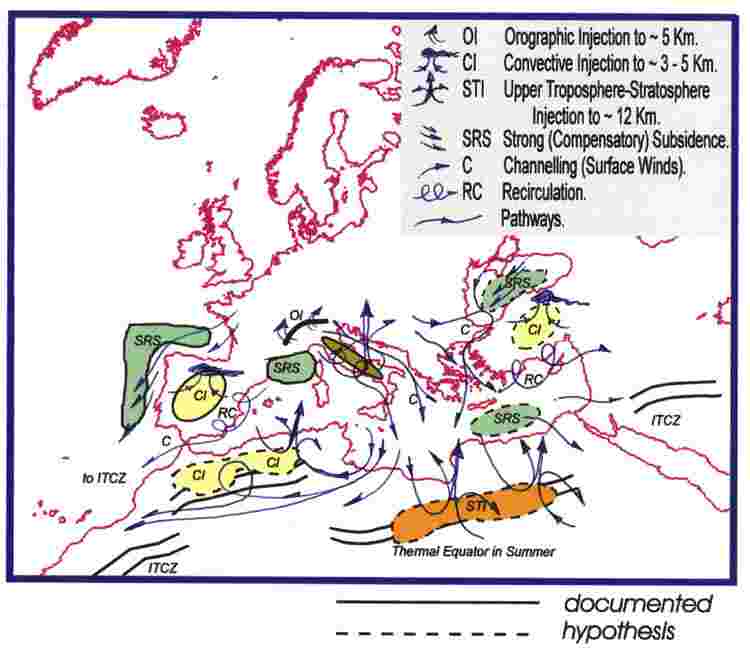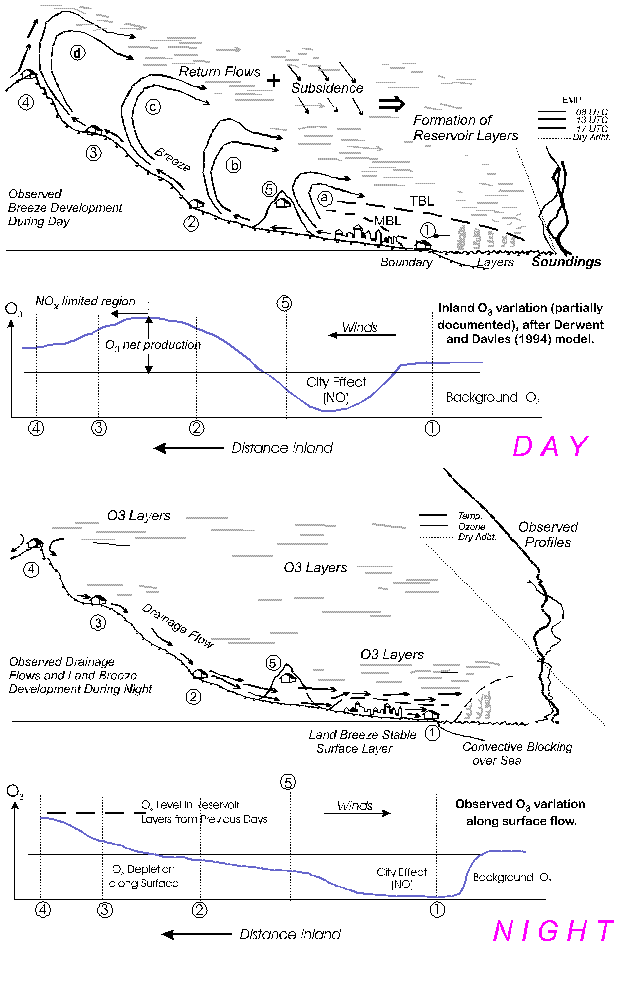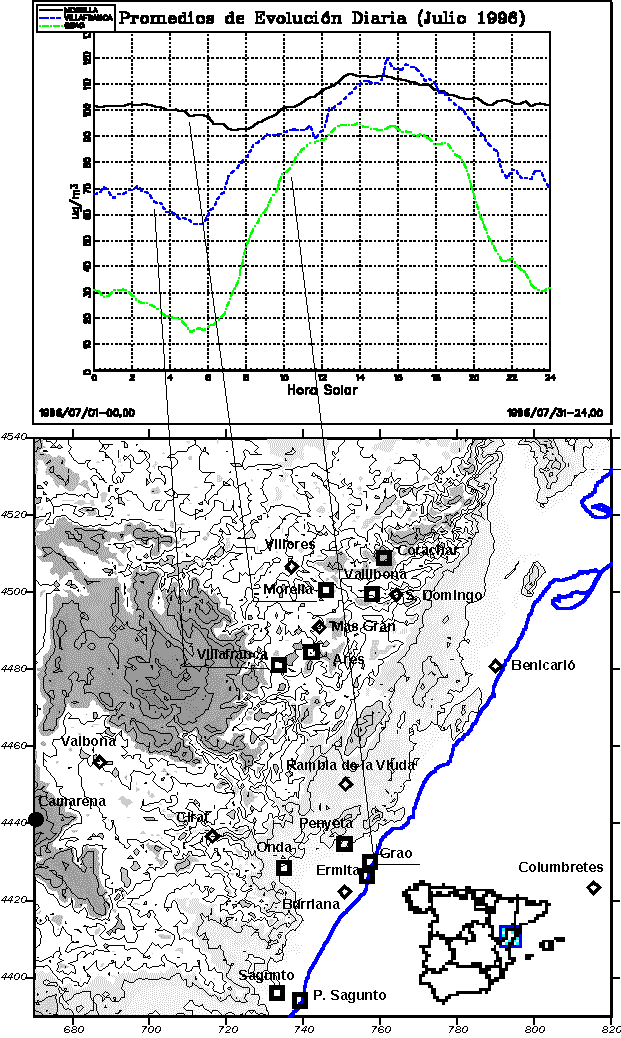Appendix 3: Ozone in southern Europe
Based on a contribution by Millán M. Millán, CEAM, Spain
In 1973 the European Commission began supporting research into the
physico-chemical processes which govern the dynamics of air pollutants in various regions
of Europe. In particular, the six European Remote Sensing Campaigns (Guillot et al.
1979; Guillot 1985; Sandroni and De Groot 1980; Le Bras 1988) were instrumental in
documenting that polluted airmasses were mostly advected in Central Europe, i.e., Belgium
(Ghent), France (Cordemais) and in the UK (Drax), while they showed marked diurnal
oscillation cycles in the airsheds of Southern Europe, i.e., France (Lacq, Fos-Berre) and
Italy (Turbigo). The hypothesis that pollutants could be re-circulated in some regions of
Southern Europe formed the basis of other EC projects dealing with the dynamics of
photo-oxidants in the Mediterranean Basin (Millán et al. 1991, 1992, 1996, 1997).
In these projects, air pollutants were regarded as tracers of opportunity of the
atmospheric flows in mid-summer (July).
Therefore, more knowledge is now available about specific
meteorological processes in the Mediterranean and their links from the local to the
sub-continental scales as shown in Figure 1. Other EC-supported projects (Le Bras 1993;
Angeletti and Restelli 1994; Le Bras and Angeletti 1995; Cox 1997; Seufert 1997) have
further documented that the formation of ozone in summer varies greatly across Europe, and
even within the Mediterranean Basin. For example, the Western Mediterranean Basin is
surrounded by high mountains and, in summer, is under weak levels of anticyclonic
subsidence and strong insolation. These conditions favour the development of meso-scale
processes and the re-circulation of airmasses. During the same period the Eastern
Mediterranean Basin is under conditions of weak ascent and strong advection, i.e., the
Etesian winds, and the development of re-circulations is largely inhibited (Millán et
al. 1997; Kallos et al. 1997, 1998; Ziomas et al. 1998.
The Western Mediterranean Basin is surrounded by mountains 1500 m or
higher. On summer days their east- and south-facing slopes are strongly heated and act
like orographic chimneys, which favour the early formation of up-slope winds that
reinforce the sea breezes and link the surface winds directly with their return flows
aloft, and further, with their compensatory subsidence over the sea. The result is the
formation of stacked layers along the coasts with the most recently formed layers at the
top and the older ones near the sea. These reach 2 to 3 km in depth, have variable width
over land (up to 100 km), and extend more than 300 km over the sea (Millán et al.,
1992, 1996).
The layers act as reservoirs of aged pollutants, and the lower ones
can be brought inland by the sea breeze of the next day(s), creating re-circulations, as
illustrated in Figure 2. Tracer experiments on the Spanish East coast have shown that
turnover times range from 2 to 3 days. During the night the land-based processes die out,
and the reservoir layers can drift along the coasts and contribute to regional,
inter-regional and long range transport of aged pollutants. Similar processes involving
either re-circulations and/or oscillations of the aged airmasses have also been documented
in the Central Mediterranean (Ciccioli et al. 1987; Fortezza et al. 1993; Georgiadis et
al. 1994; Orciari et al. 1998).
At the larger scales, deep convection in some regions (e.g., Spanish
and Turkish central plateaus), or strong up-slope winds in others (e.g., Alps and Atlas
mountains), can inject aged air masses directly into the Mid-troposphere (3 to 6 km) and
into the upper troposphere, i.e., 10 (+) km, where they can participate in long-range
transport processes within Southern and Central Europe, and at the continental-global
scales, respectively.
Under strong summer insolation, the coastal re-circulations become
"large natural photo-chemical reactors" where most of the NOx
emissions and other precursors are transformed into oxidants, acidic compounds, aerosols
and O3, leading to the exceedance of EC thresholds (Figure 3). Relevant aspects
of this problem are: (1) that the concept of upwind (background) and downwind of
conurbations (polluted) is inappropriate in regions of complex coastal terrain where
re-circulation processes are important, (2) that ozone is generated at the regional scale
from emissions in urban centres and other NOx source areas, and (3) that as
much as 60%, or more, of the observed O3 at any one site may result from
advection within the recirculating air masses.
These situations are the norm, rather than the exception, for the
coastal regions surrounding the Western Mediterranean Basin, and illustrate the existence
of chronic-type O3 episodes, created by atmospheric re-circulations, as
compared with the peak-type episodes in Central and Northern Europe, which are created by
combinations of long-range transport and atmospheric stagnation. They also reveal a
problem of data interpretation for those responsible for monitoring networks from the
local to the EC level.
Thus, in Southern Europe and the Mediterranean Basin the observed O3
cycles depend strongly on the topographic location of the observing station and its
relationship to the reservoir layers, the atmospheric circulations involved, and the
chemical processes along each path (Derwent and Davies, 1994), as illustrated in Figures 2
and 3. As a result, each O3 monitoring station shows a part of the whole, and
could even be considered to represent a specific area, providing the relevant processes
are understood for each site and the site itself has been adequately selected; however, no
single station can be considered representative of regional processes, and much less of
the whole situation.

Figure 1: A schematic summary of the observed and
postulated circulations for the whole Mediterranean on a summer day.

Figure 2: Sketch of the diurnal circulations in the
coastal regions of the Mediterranean Basin in summer. The entrance of the sea breeze
during the day and the formation of stratified (reservoir) layers aloft is illustrated,
and letters (a) to (d) indicate successive stages in this process. The upper part (DAY)
shows a schematic of the ozone decay, and subsequent production, as it interacts with the
emissions of nitrogen monoxide (NO) in a coastal city (Derwent and Davies, 1994). During
the night drainage flows are formed and a stable airmass accumulates at the bottom of the
valleys and over the coastal plains. The draining airmass can become blocked at some
distance from the coast whenever the sea surface temperature is higher than that of the
air. The lower part (NIGHT) shows a schematic of the ozone evolution along the path of the
draining air. In these processes, stations located high above the coastal plains (#5) can
remain within the reservoir layers during the night. The number codes correspond to the
stations in Figure 3.

Figure 3: Daily ozone cycles in July for three stations
located at various heights and distances inland from the Spanish East Coast. At the coast
(Grao, type #1) the O3 drops to low values during the night and rises sharply
between 0700 and 1000, just before the onset of the sea breeze. This is associated with
the fumigation of O3 from the reservoir layers. After this time it remains
nearly constant and can be regarded as the background O3 entering with the sea
breeze. In Villafranca (type #3), some O3 is available from the reservoir
layers, and the concentrations do not drop below 60 mg/m3 during the night.
After the morning rise the O3 remains nearly constant until the arrival of the
sea-breeze front at 1200 and 1400, which produces a second rise in O3 and the
diurnal maximum by 16:00. Finally, the mountain site (Morella, type #4) remains within the
reservoir layers during the night. The O3 remains high, its daily cycle is
dampened, and it shows a minimum by 08:00 which, not surprisingly, coincides with the time
of maximum rise at the sites on the coast and valley floor.




Document Actions
Share with others